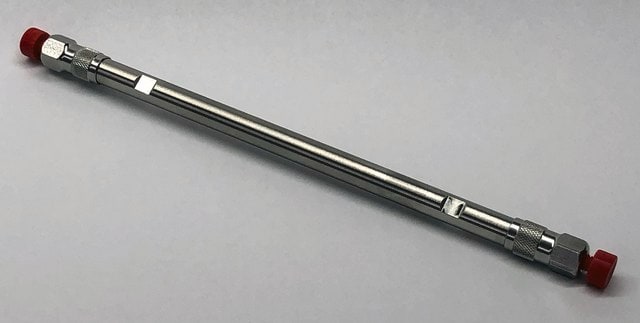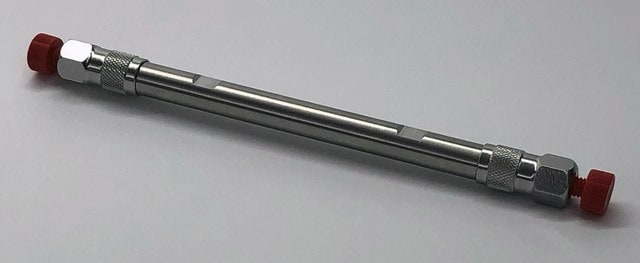565324-U
Ascentis® RP-Amide HPLC Column
5 μm particle size, L × I.D. 15 cm × 4.6 mm
Recommended Products
material
stainless steel column
Agency
suitable for USP L60
product line
Ascentis®
feature
endcapped
manufacturer/tradename
Ascentis®
packaging
1 ea of
extent of labeling
19.5% Carbon loading
parameter
≤70 °C temp. range
400 bar pressure (5801 psi)
technique(s)
HPLC: suitable
LC/MS: suitable
L × I.D.
15 cm × 4.6 mm
surface area
450 m2/g
surface coverage
2.7 μmol/m2
impurities
<5 ppm metals
matrix
fully porous particle
silica gel high purity, spherical
matrix active group
amide, alkyl phase
particle size
5 μm
pore size
100 Å
operating pH range
2-8
application(s)
food and beverages
separation technique
reversed phase
Looking for similar products? Visit Product Comparison Guide
General description
Ascentis RP-Amide is a new generation ultra low bleed, embedded polar group (EPG) phase that provides orthogonal selectivity and increased resolution for HPLC and LC-MS analysis of polar compounds. The Ascentis RP-Amide is the first choice in embedded polar group HPLC phases.
Features and Benefits
- Excellent retention and peak shape for polar compounds
- 100% aqueous compatibility
- Ultra low bleed, LC-MS compatible
- Unique selectivity
Legal Information
Application
guard cartridge
Certificates of Analysis (COA)
Search for Certificates of Analysis (COA) by entering the products Lot/Batch Number. Lot and Batch Numbers can be found on a product’s label following the words ‘Lot’ or ‘Batch’.
Already Own This Product?
Documents related to the products that you have purchased in the past have been gathered in the Document Library for your convenience.
Difficulty Finding Your Product Or Lot/Batch Number?
How to Find the Product Number
Product numbers are combined with Pack Sizes/Quantity when displayed on the website (example: T1503-25G). Please make sure you enter ONLY the product number in the Product Number field (example: T1503).
Example:
Additional examples:
705578-5MG-PW
PL860-CGA/SHF-1EA
MMYOMAG-74K-13
1000309185
enter as 1.000309185)
Having trouble? Feel free to contact Technical Service for assistance.
How to Find a Lot/Batch Number for COA
Lot and Batch Numbers can be found on a product's label following the words 'Lot' or 'Batch'.
Aldrich Products
For a lot number such as TO09019TO, enter it as 09019TO (without the first two letters 'TO').
For a lot number with a filling-code such as 05427ES-021, enter it as 05427ES (without the filling-code '-021').
For a lot number with a filling-code such as STBB0728K9, enter it as STBB0728 without the filling-code 'K9'.
Not Finding What You Are Looking For?
In some cases, a COA may not be available online. If your search was unable to find the COA you can request one.
Articles
Reference Standards for Analyzing Polyphenol Catechins
Protocols
Mass Spectral Column Bleed in Nitrogen-Containing Polar-Embedded HPLC Stationary Phases
Separation of (L)-Dehydroascorbic acid; L-Ascorbic acid 20 μg/mL
Separation of Resorcinol 50 mg/mL; Pyrocatechol; 2-Methylresorcinol; 4-Methylcatechol; 2,5-Dimethylresorcinol 50 mg/mL; 3-Methylcatechol 50 mg/mL; 4-Nitrocatechol 50 mg/mL
HPLC Analysis of Carotene Compounds on Ascentis® RP-Amide
Chromatograms
application for HPLCapplication for HPLCOur team of scientists has experience in all areas of research including Life Science, Material Science, Chemical Synthesis, Chromatography, Analytical and many others.
Contact Technical Service





